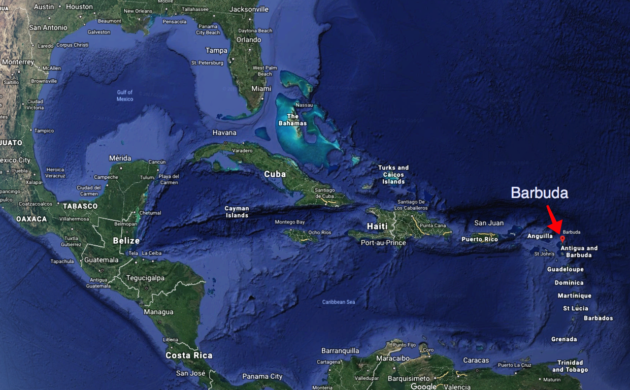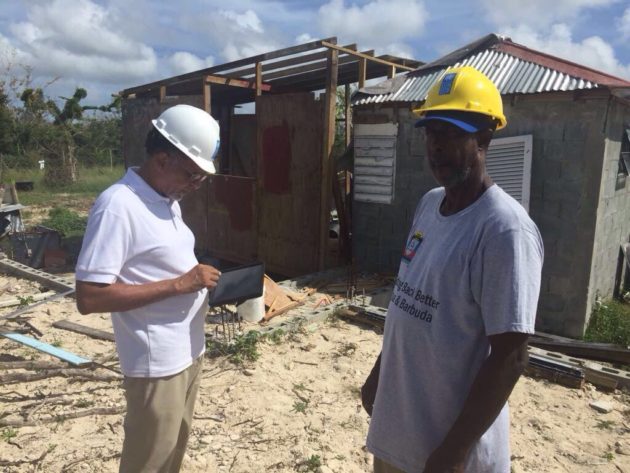CODRINGTON, Barbuda — Last month at a United Nations donor conference, the international community pledged $1.3 billion to rebuild the hurricane-ravaged Caribbean.
But how did they know how much the region, which was hit with back-to-back Category 5 hurricanes in September, needs to recover?
In part thanks to a new app and software bundle from Microsoft, developed in collaboration with U.N. relief workers.
The prosaically named Building Damage Assessment app turned out to play a vital role in assessing the devastation of Barbuda and Dominica, two islands that faced the full force of Hurricanes Irma and Maria, respectively. Optimized for tablet, the Building Damage Assessment allows volunteers in the field with minimal training to quickly input data about structural damage through a series of drop-down questions, and collect photographs for visual evidence. The data is stored offline and then uploaded via the cloud when the tablet gets back in mobile data or wi-fi range. Professionals, meanwhile, can analyze the data using Microsoft Power BI to tabulate the total amount of damage and detect trends, like certain types of building materials that were more prone to collapse.

The results have impressed even seasoned post-disaster professionals like Ugo Blanco of the United Nations Development Program (UNDP). “It’s going to change the way assessments have been done,” he said. “It can be deployed any time, anywhere. In a few days, we can have the teams in any country in the world.”
Microsoft developed a beta iteration of the Building Damage Assessment in 2015 as part of its humanitarian responses to the earthquakes in Nepal, but the software didn’t come into its own until this year’s double-whammy of hurricanes, when UNDP reached back out for technical assistance. The software giant allocated ten employees to the project and donated 70 Microsoft Surface tablets as well as keyboards and digital pens for use in the field, part of a $6.3-million post-hurricane philanthropic contribution.
Unlike a traditional software project, the client — the United Nations — needed the final product as soon as possible. “With people suffering, moving fast was really important, and we felt that the time that normal application development takes would not work in this situation,” Microsoft’s Humanitarian Response Manager Cameron Birge said via e-mail. “Given UNDP’s need to rapidly deploy, this meant the team had to respond and react more quickly, as challenges in information gathering and UX arose.”

A month after the storms, the Building Damage Assessment was ready to go. Barbuda is home to 1,600 people, all of whom were evacuated after Hurricane Irma. In early November, its 1,250 structures became the first complete assessment on a hurricane-hit island. Only a few United Nations relief workers were on the ground, so the U.N. staff recruited local volunteers and put them into 12 teams that fanned out across Codrington, Barbuda’s lone settlement.
Each team included a volunteer trained in the Building Damage Assessment app, an architect or building engineer who could assess damage, and a local who knew the neighborhood and its residents. In 10-15 minutes, the team would determine the state of the building and collect as much information as possible about the inhabitants – family size, gender, age, occupation – in a series of 46 questions.
Adradene Walker was one of the volunteers handling a tablet. After an hour-long orientation workshop, she was sent out into the field and said working with the brand-new app was a breeze.

“Everything was straightforward,” she told me. “It was even easier than some online forms.” Walker has some data-entry experience from her job as a secretary at the Barbuda secondary school. She owns a smartphone and an HP 3-in-1 laptop. With drop-down menus, the app is designed to be easy to use for anyone with mobile technology literacy.
In five days, the teams assessed all of the buildings on Barbuda in time for the donor conference at U.N Headquarters. While initial reports in the immediate aftermath of the storm indicated that 90% of buildings on Barbuda were damaged, the Building Damage Assessment determined that about half of the structures are ready to move back in or need relatively minor, handyman-level repairs. The other half need serious repairs or have to rebuilt from scratch. That kind of data helped the U.N. determine the rough cost of $79 million to repair and rebuild Barbuda’s housing stock, the kind of hard number necessary to make a pledging conference yield valuable results.
Using technology in post-disaster scenarios is not without pitfalls, of course, especially given power outages. Generators continue to govern life on Barbuda, and nearby Antigua, 39 miles away, offered a stable place to return at the end of the day with reliable electricity and Internet. (Antigua and Barbuda is a twin-island country.) Dominica has proven a more daunting task. There are 25,000 structures to be assessed by 30 teams. UNDP estimates it will take two months to finish the job there. As power is slowly restored, police stations are the only reliable source of electricity in remote areas. Tablets also must weather difficult conditions – several overheated in the Barbuda sun – so cases are de rigueur.

Fortunately, the Microsoft Surface Pro 3 can work offline and still collect GPS coordinates. With mobile roaming data, the app can upload 30 questionnaires in ten seconds to collect the most vital data, while photos can be held until there is a WiFi connection.
As the tool continues its work in Dominica, UNDP and Microsoft are already discussing future improvements to user experience, like further streamlining the questionnaire to minimize keyboard entries, which are prone to errors in the high-pressure field environment.
The tool’s desktop data analysis has also helped build local capacity in an underdeveloped region. “The Building Damage Assessment gave us information that the government has never had before,” Blanco said, citing detailed info among the million-plus data points on the location of damaged buildings, the type of debris, and what kinds of roofs were most prone to failure. He describes the user-friendly visual display as valuable for technicians at a housing ministry but also easy-to-understand for a prime minister or president.
“This information is critical evidence,” Blanco said. “You can make policy decisions on how to rebuild.”
Above all, the Building Damage Assessment has proven that a digital approach is the future of disaster relief. “I’ve been in many post-disaster situations. In the best case we’ve had info we can’t use – thousands of pages we did not have time to go through or input to Excel,” Blanco said. “We are dealing with millions of data points. You cannot do that with paper.”




